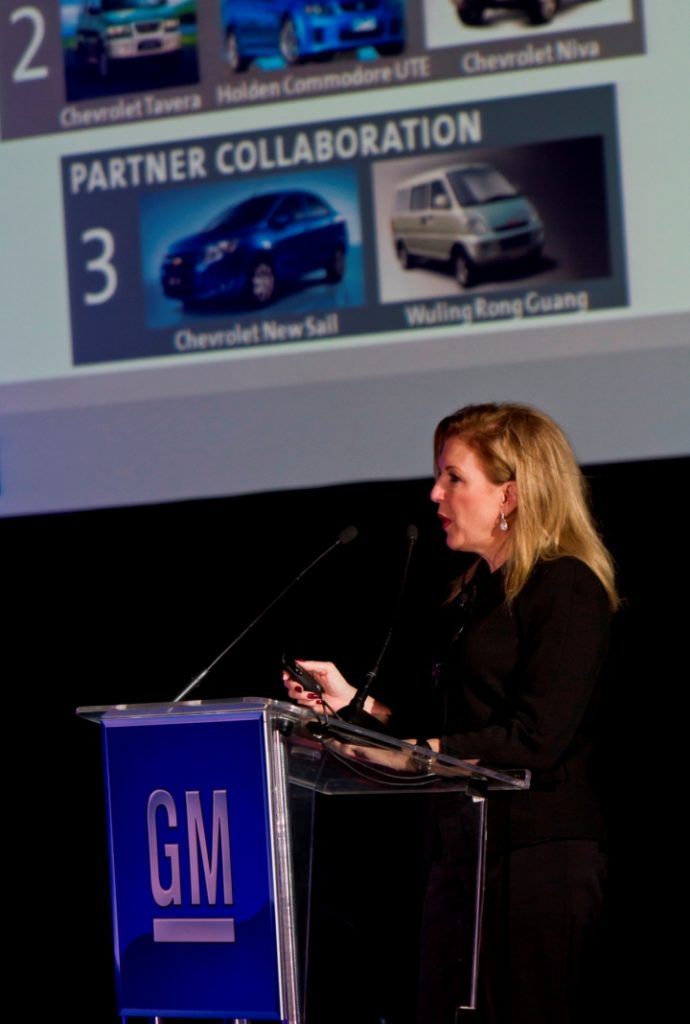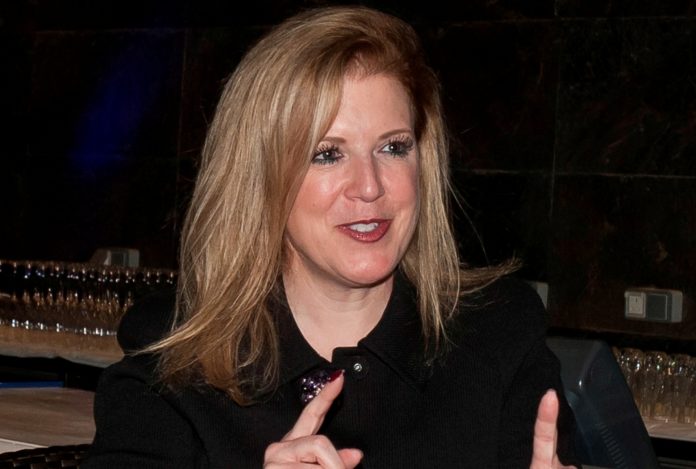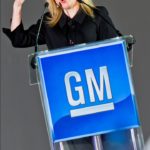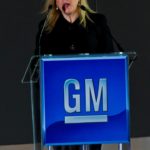On the sideline of the 2010 Abu Dhabi International Motor Show, Venture discussed GM’s return to health and their plans for the future, the Middle East and world markets with Susan Docherty, GM’s recently appointed Vice President International Operations, Sales, Marketing and Aftersales. A rising star within GM, Docherty is a twice previous GM Vice President for US Marketing and for US Sales, Service and Marketing as well as a previous General Manager for Buick-Pontiac-GMC.
With General Motors International Operations’ (GMIO) remit spanning 75 markets, 80% of the world’s population and 51% of the world’s automotive industry, Shanghai-based Docherty reports a 29% year-on-year growth for GMIO, record sales in China, India and Egypt during 2010 as well as GM becoming the firs global OEM to sell 2 million units in China, and expects that Chevrolet will account for 55% of GM’s global sales by 2012. GM: What are the key changes instituted at General Motors (GM) since its’ restructuring and how have they benefitted the company?
GM: What are the key changes instituted at General Motors (GM) since its’ restructuring and how have they benefitted the company?
SD: In terms of the new company, there’s been a dramatic change in our brand footprint. I think the world is very aware of the fact that we eliminated the Pontiac, Saturn and Hummer brands, and sold the Saab brand. We have a smaller footprint and addressed many of our legacy costs that have hurt us for many years and did not enable us to be competitive with some the global OEMs like Toyota, Honda and VW. Our newly restructured balance sheet has little debt and our new CFO Chris Liddell has been very public about the fact that we want to have a balance sheet that has very little debt on it and we’ve been able to reduce and lower the breakeven point in the company so that if we ever face another economic downturn like what we saw in 2009 in the United States where the industry went to about 10 million units on an annual basis we can be able to be profitable. Prior to our restructuring we never could have achieved that. Our new company is a mix of new individuals who have come on not only for our board of directors but also in key management positions – Individuals like Chris Liddell, our CFO that we brought from Microsoft, Dan Akerson, who is our new CEO as of Sptember 1st who comes as one of the managing partners for the Carlyle Group. Then of course just prior to Dan Akerson we had Ed Whitacre who was our CEO who was the retired Chairman and CEO of AT&T. And bringing in just those three examples of individuals who are brand new to the automotive industry, they come with a fresh set of eyes to our business. The other comment I would make is that we have a brand new vision for the company that is very simple, it is very focused, and that is to design, build and sell the world’s best vehicle, and it doesn’t matter if you’re in Dubai, Tokyo, Shanghai, Detroit or Toronto, there isn’t any employee in our company that doesn’t know what our vision is. We’ve reduced layers and layers of bureaucracy within our company and when you have a simple vision such as that, it helps guide the decisions you make. I’ve often been asked by journalists: aren’t you concerned about making sure that you’re No.1 in market share or No. 1 in production? No, if you start with a vision to design, build and sell the world’s best vehicle you’re not lured into buying market share, but you are focused on building world class vehicles, building long-term brand health and then of course making sure that every single day we’re listening to what customers want. In my role in GMIO at sales and marketing we have diverse set of countries with customers with very diverse sets of needs, you need to manage on many different levels and always having this focus on designing, building and selling the best helps you make decisions clearly. GM: How effective was the US Government’s financial bailout and how has it helped GM’s comeback?
GM: How effective was the US Government’s financial bailout and how has it helped GM’s comeback?
SD: First of all, it wasn’t help from just one government, we received financial assistance from the American taxpayer as well as the American Government and the Canadian Government, and without the assistance of Canadian and US citizens’ taxpayer Dollars we wouldn’t have been able to do what we did in the last 18 months. And at this point as we have restructured the company and many people talk about this as something that they may not have wanted to do but what we were looking to do in our company was not a hand out but a hand up, and I think that there’s a difference here, we knew we needed help and we are incredibly humbled and grateful for the help we got from both US and Canadian governments and now that we have become a public company again – we did our official public offering on both the Canadian stock exchange in Toronto and the US stock exchange in New York – we have had people from all around the world put their financial faith in us and it’s up to the leaders of the new General Motors to assure them and give them confidence that they made the right investment in our stock and we need to prove to them every single day that they made the right choice and investment by getting our company very healthy again. I think you’ve probably seen in the 2010 calendar year we have had three quarters of profits and the profit that we recorded in Q3 of 2010 was the best profitable quarter we had in 11 years as a company. So our balance sheet is corrected, we have a new management team that is a healthy mix of both the old management team and the new management team, we’re designing, building and selling the world’s best vehicles, we’re unencumbered by debt, we’re set up for growth and what we’re seeing is that consumers certainly didn’t expect us to be on an IPO as quickly as we did, but it’s nice to have that behind us because what we is the dialogue to not to be about the health of our company and whether or not we’re public. We want the dialogue to be about our great brands and making customers happy – that’s how you build long term equity for a brand and get people to invest in our brands with their hard-earned Dollars and get them to buy our products again and again.
GM: With some of GM’s operations, like the Middle East, already healthy before the economic crisis, how have these broad changes affected GM’s international operations?
SD: In terms of our focus in the International Operations we know that we are the fuel of GM’s future growth. We do have some markets around the globe that are quite mature markets like Japan, Australia, the United States and Canada, but we have other areas of the world whose growth will set us up for the future. Those are countries Brazil Russia, India, China (BRIC) as well as the Middle East, places that when we look forward, we can still see double digit growth in those countries. For GMIO we’re lucky that we have responsibility for three of the BRIC countries, namely China, Russia and India, and one of the things that is fueling that growth is the emergence of youth that are coming to driving age and we’re making sure that in places like the Middle East where the majority of the population is under the age of 30 that we’re continuing to build our brands: Chevrolet, GMC and Cadillac, so that as people come of driving age we’ll be on their consideration list. GM: Will GM’s focus now be on producing one-solution world cars or will we be seeing a more region or market specific approach?
GM: Will GM’s focus now be on producing one-solution world cars or will we be seeing a more region or market specific approach?
SD: We’re gonna see a three-pronged approach. In the three-pronged approach that you are going to see is leveraging a global platform, and we have a number of those that we’ve executed with success – in products that you see like the Buick LaCrosse, which is a vehicle and global platform that has been a smashing hit both in the United States as well as China. We’re also going to have some vehicles that we will produce only in a particular region. A product that comes to mind there would be the Chevrolet Niva, which is our bestselling vehicle in Russia or a product like the Chevrolet Sail, which is doing exceptionally well in China. And then the third part of our strategy is what we would call partner-collaboration, and in places like China as well as India and even Russia, we’ve partnered up with some companies. In China for example, our partner is a SAIC, where we partner with them to produce in-country products like the Chevrolet Cruze, the Buick Regal, the Buick LaCrosse and others, or our joint venture with Wuling, where all of our light commercial vehicles in China are all done through partner collaboration with Wuling. I think that the best example of a world car right now that we’re selling in well over 65 countries is the Chevrolet Cruze, and believe it or not, the last country for us to launch the Chevrolet Cruze was the United States – We actually launched it in places like China, Australia, India and Russia before we launched it in the US. I think that what that points out is that… yes we’re an American-based company but we fully recognize that for our brands and a lot of our products to be successful, starting their launch activities in countries other than America enables them to gravitate and gain some great momentum. We’ve actually sold over 250,000 Cruzes worldwide before we ever even launched it in the United States, and I think that for a brand like Chevrolet that is an American icon, for us to be launching those products outside of the United States, first is very cool… Another good example of a car I would call a world car in many aspects is the Chevrolet Aveo. We did the world premier of the Chevrolet Aveo in mid-September at the Paris International Auto Show, and again that’s another example of a product from Chevrolet that will go on sale in many other countries before we even actually introduce it in the United States. So, to us the globe really presents great opportunities for us to get momentum going on products. I think that some of the magic that becomes really important, whether you’re in India, Dubai or Shanghai, people can have an affinity for these brands even though they come from very different cultures and they have very different entrance points into the market – when we think about the Cruze in the United States, the average age of the buyer will probably be in their mid-40s. When we think of the Cruze in China, the average age of that buyer will be less than 30. They’re different customers but they all gravitate towards a power but the brand is much like you see with the Apple iPhone. Apple is a great American brand, but the world has embraced the iPhone as theirs, and that’s what we’re trying to do with our brand – even GMC, people here in the Middle East believe that that’s their brand.
GM: Absolutely, that seems particularly so for GMC, considering it’s only sold in the US and the Middle East.
SD: Believe it or not, but the health of the GMC brand in the Middle East is actually stronger, in terms of opinion and consideration than what it is in the United States. That’s important because if the brand is very aspirational and strong here, that effect helps other countries.
GM: Are GM pitching certain models or brands at a higher or more aspirational level for international markets than they would be for the US?
SD: That’s a great question, I think the best way to answer that would be to talk about our brand architecture. We have one truly global brand and that brand is Chevrolet and we want Chevrolet to be our powerhouse value brand with terrific quality, a brand that embodies enduring quality, authentic, spirited, a brand that’s all about imagination and discovery. The Chevrolet brand in the 2011 calendar will celebrate its’ 100th anniversary and it’s something we’re exceptionally proud of. Then we have what I would call international brands. International brands are sold in more than one region. A good example of an international brand would be Opel. We sell the Opel brand in Europe but we also export the Opel brand and we sell that brand as well in international operations and we also sell it in South America, in Chile. The third example of our brand architecture is regional brands. That would be a brand like Holden where we only sell in one region of the world and that happens to be Australia and New Zealand in our General Motors International Operations region. But GMC, just coming back to your comment about that one, is classified as an international brand because we sell in Canada, the United States and of course the Middle East.
 GM: What I’m getting to is that whether something like a Chevrolet Corvette or Camaro, is being pitched as more aspirational in the Middle East or other international markets?
GM: What I’m getting to is that whether something like a Chevrolet Corvette or Camaro, is being pitched as more aspirational in the Middle East or other international markets?
SD: Corvette and Camaro play a halo role and add a tremendous value to the Chevrolet brand where we sell it. We actually are going to be introducing the Camaro and Corvette into some of our international markets because what it does is it lifts the value of the Chevrolet brand. We have a lot of people in China who are familiar with Chevrolet and they see the Chevrolet Sail, Spark and Aveo on the road but what adding a Camaro or Corvette to the portfolio does is it really gives the brand special cache when you see those kinds of products on the road. We’re going to use Corvette and Camaro selectively especially where we think it’s appropriate to move the brand a bit upmarket.
 GM: How important is the Middle East market to GM and what are GM’s projections for sales, profits and market share in the region?
GM: How important is the Middle East market to GM and what are GM’s projections for sales, profits and market share in the region?
SD: In terms of market share, we don’t have data that has fidelity that I look at but what I do look at on a monthly basis is where the industry is at. What I’m very encouraged by here in the Middle East is that the industry right now is about 1.1 million units annually and it will grow to 1.8 million units through 2020. The reason why that’s important to understand where the industry is going is we’ll experience double digit growth of 55% from now to 2020. So one of the things that John Stadwick (President and Managing Director, GM Middle East Operations) and his team need to do is make sure that we’re set up for that future growth and that we have healthy brands in Chevrolet, GMC and Cadillac to make sure that we’re addressing consumers’ evolving needs. It’s a very important market for us and what’s nice about this market is that we had these three brands in the market for many decades, so we’ve got history here, we’ve got origin here and we have a very strong dealer network here. One of the things we’re always concerned about is making sure that we can deliver world class customer experiences at our dealerships, and the team is working really hard on that.
GM: Is there a new global marketing approach or branding strategy for “new” GM?
SD: I think that the biggest difference that you’ll see in the new GM, because of the fact that we’ve reduced our brand footprint, is that you can see a lot more focus, and to use the United States as an example where less than 12 months ago we went to market with eight brands and now we’re going to market with only four brands, and those four brands are Chevrolet, Buick, GMC and Cadillac. We have been able in the United States to maintain our market share with only four brands instead of eight and I think what it shows you is that the power of being able to focus and to be able to take the available resources that we have and rather than peanut butter approach them across eight brands, we can get very focused on what we need to get done with Chevrolet, Buick, GMC and Cadillac. It also helps us in terms of differentiating those brands, about exactly what we want Chevrolet to represent, what we want Buick to represent, GMC, etcetera. I think what you’ll also see in the new GM from a marketing standpoint is a lot greater connection with our consumers. One of the things that I worked on was this idea of customer sales and service retention. We want to be able to develop these relationships with our consumers, not just when they buy a vehicle but throughout their whole ownership cycle, and bringing them back to the dealership and understanding what they’re looking for. Some of the ways we’re able to do that, especially in the US is with the connection we have with On Star (GM-owned subscription-based vehicle communications systems and services). All of our vehicles in the United States come with On Star, and what happens when you do that is consumers give us their email and every month they get a health report card on their car and so it creates a connection with consumers about say ‘the manufacturer knows me’, ‘they know how many miles I’ve driven’, ‘they know when I need an oil change’, because the car becomes an integral part of the relationship that they have with the brand. I think that you’ll see a lot more marketing that creates a special bond with the consumer.
































Recent Comments